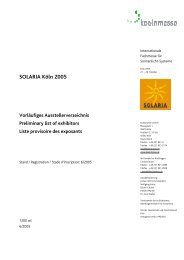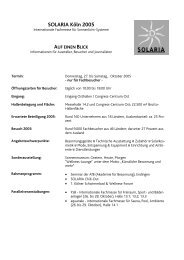2006;56;106-130 CA Cancer J Clin Smigal and Michael J. Thun ...
2006;56;106-130 CA Cancer J Clin Smigal and Michael J. Thun ...
2006;56;106-130 CA Cancer J Clin Smigal and Michael J. Thun ...
Create successful ePaper yourself
Turn your PDF publications into a flip-book with our unique Google optimized e-Paper software.
<strong>CA</strong> <strong>Cancer</strong> J <strong>Clin</strong> <strong>2006</strong>;<strong>56</strong>:<strong>106</strong>–<strong>130</strong><br />
TABLE 9 Trends in the Recorded Number of Deaths for Selected <strong>Cancer</strong>s by Sex, United States, 1989<br />
to 2003<br />
Note: Effective with the mortality data for 1999, causes of death are classified by ICD-10, replacing ICD-9 used for 1979 to 1998<br />
data.<br />
Source: US Mortality Public Use Data Tapes, 1989 to 2003, National Center for Health Statistics, Centers for Disease Control<br />
<strong>and</strong> Prevention, <strong>2006</strong>.<br />
cancer sites than are rates in Whites <strong>and</strong> African<br />
Americans. However, incidence <strong>and</strong> death rates<br />
for cancers of the uterine cervix, stomach, <strong>and</strong><br />
liver are generally higher in minority population<br />
than in Whites. Stomach <strong>and</strong> liver cancer incidence<br />
<strong>and</strong> death rates are more than twice as high<br />
in Asian/Pacific Isl<strong>and</strong>ers as in Whites, reflecting<br />
increased exposure to infectious agents such as H.<br />
pylori <strong>and</strong> Hepatitis B virus. 15<br />
Trends in cancer incidence can only be adjusted<br />
for delayed reporting in Whites <strong>and</strong> African Americans,<br />
<strong>and</strong> not in other racial <strong>and</strong> ethnic subgroups<br />
because the long-term incidence data required for<br />
delay adjustment are available only for Whites <strong>and</strong><br />
for African Americans. From 1992 to 2002, incidence<br />
rates for all cancer sites combined, not adjusted<br />
for delayed reporting, decreased by 2.7% per<br />
year among American Indians/Alaskan Natives, by<br />
1.0% per year in African Americans, by 0.6% among<br />
Asian/Pacific Isl<strong>and</strong>ers, <strong>and</strong> by 0.4% among<br />
Hispanic-Latinos <strong>and</strong> Whites. Similarly, the death<br />
rate for all cancers combined decreased from 1992<br />
through 2002 by 1.7% per year in Asian/Pacific<br />
Isl<strong>and</strong>ers, by 1.5% among African Americans, by<br />
0.9% among Whites, <strong>and</strong> by 0.6% among Hispanic-<br />
Latinos. The death rate from all cancers combined<br />
stabilized during this time period among American<br />
Indians/Alaskan Natives. 3<br />
Lifetime Probability of Developing <strong>Cancer</strong><br />
The lifetime probability of developing cancer<br />
is higher for men (46%) than for women (38%)<br />
(Table 11). However, because of the relatively<br />
early age of onset of breast cancer, women have a<br />
slightly higher probability of developing cancer<br />
before the age of 60 years. It is noteworthy that<br />
these estimates are based on the average experience<br />
of the general population <strong>and</strong> may over or<br />
under estimate individual risk because of differences<br />
in exposure <strong>and</strong>/or genetic susceptibility.<br />
<strong>Cancer</strong> Survival by Race<br />
Compared with Whites, African American<br />
men <strong>and</strong> women have poorer survival once a<br />
cancer diagnosis is made. As shown in Figure 7,<br />
African Americans are less likely than Whites to<br />
be diagnosed with cancer at a localized stage,<br />
when the disease may be more easily <strong>and</strong> successfully<br />
treated, <strong>and</strong> are more likely to be<br />
diagnosed with cancer at a regional or distant<br />
stage of disease. Five-year relative survival is<br />
lower in African Americans than Whites within<br />
each stratum of stage of diagnosis for nearly<br />
every cancer site (Figure 8). These disparities<br />
may result from inequalities in access to <strong>and</strong><br />
receipt of quality health care <strong>and</strong>/or from dif-<br />
Downloaded from caonline.amcancersoc.org by guest on September 27, <strong>2006</strong> (©American <strong>Cancer</strong> Society, Inc.)<br />
Volume <strong>56</strong> Y Number 2 Y March/April <strong>2006</strong> 121



![811 IARC vitamin D and Cancer Report_VitD[1] - Sunlight Research ...](https://img.yumpu.com/25304592/1/184x260/811-iarc-vitamin-d-and-cancer-report-vitd1-sunlight-research-.jpg?quality=85)











